
French postcard, no. 1118. Photo: Warner Bros. Inc. Michael Keaton in Batman (Tim Burton, 1989).
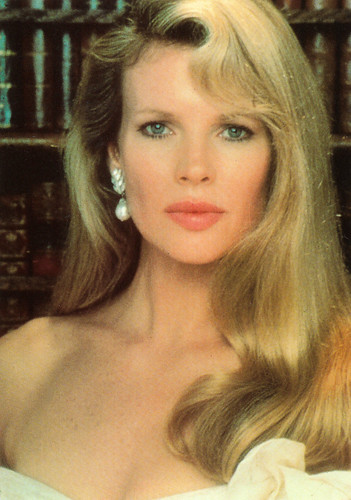
British postcard by Heroes Publishing Ltd., London, no. SPC2429. Kim Basinger in Batman (Tim Burton, 1989).

German autograph card by Bravo. Photo: Michael Keaton in Batman (Tim Burton, 1989).
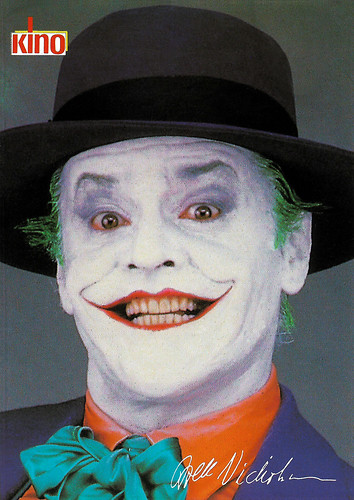
German autograph card by Kino. Photo: Jack Nicholson in Batman (Tim Burton, 1989).
There's a new crime fighter in town
The location of Batman (Tim Burton, 1989) is Gotham City - a big and very unsafe city. Crime boss Carl Grissom (Jack Palance) effectively runs the town but there's a new crime fighter in town - the mysterious Batman (Michael Keaton), a very capable fighter in a bat costume, on whom bullets seem to have little effect.
Grissom's right-hand man is Jack Napier (Jack Nicholson), a brutal man who is not entirely sane... Napier turns out to have a secret relationship with Grissom's mistress Alicia (Jerry Hall). Grissom learns of the affair and covertly informs the police of a robbery in order to have Napier eliminated.
Napier falls to his apparent death in a vat of chemicals. However, he soon reappears as The Joker and starts a reign of terror in Gotham City. Meanwhile, journalist Alexander Knox (Robert Wuhl) and photographer Vicki Vale (Kim Basinger) are in the city to do an article on Batman. Vicki soon starts a relationship with Batman's everyday persona, eccentric billionaire Bruce Wayne.
The idea of making a film about Batman came up in 1980. Tom Mankiewicz, who had co-written the screenplay for Superman (Richard Donner, 1978), wrote the first draft of a screenplay, in which the origin of Batman was told, with the Joker and Penguin as the bad guys. Robin would appear in costume at the end of the film.
The film was due for release in 1985 but was delayed until the project was picked up by producers Jon Peters and Peter Gruber. They recruited Tim Burton to direct after his film Pee-wee's Big Adventure (Tim Burton, 1985) became an unexpected success. Burton rewrote a revised version with his then-girlfriend Julie Hickson, and in 1986 commissioned Sam Hamm to write a new screenplay based on his changes.
In 1988, the project was given the green light after Burton's Beetlejuice (Tim Burton, 1988) proved to be a great success. In September 1988, the film went into production, and filming began in October. By December, the film was finished. Gotham City was designed by British designer Anton Furst. The bleak, urban set design was reminiscent of the sets of films like Metropolis (Fritz Lang, 1927) and Blade Runner (Ridley Scott, 1982).
Furst deliberately combined several architectural styles, so that Gotham City did not come from a clear period of time and the city appeared very ugly and desolate. When it was announced that the film was to be made, fans of the comic book series feared that the film would take on the light-hearted, farcical tone of the 1960s television series. The choice of Michael Keaton as Batman played a major role in this, as Keaton had until then been known mainly for his work in light film comedies.
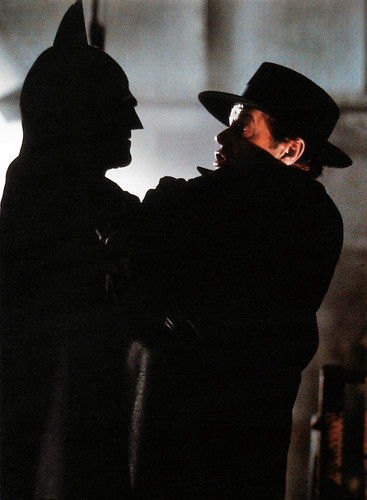
British postcard by Athena International, BAT, no. 10, 1989, no. 0334340. Photo: TM / DC Comics Inc. Michael Keaton and Jack Nicholson in Batman (Tim Burton, 1989).
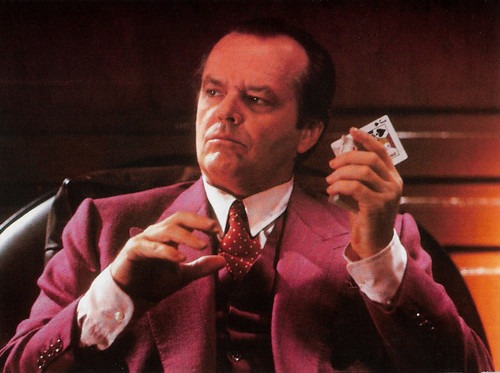
British postcard by Athena International, BAT, no. 11, 1989, no. 0334341. Photo: TM / DC Comics Inc. Jack Nicholson in Batman (Tim Burton, 1989).

British postcard by Athena International, BAT, no. 12, 1989, no. 0334342. Photo: TM / DC Comics Inc. Jack Nicholson in Batman (Tim Burton, 1989).

British postcard by Athena International, BAT, no. 15, 1989, no. 0334345. Photo: TM / DC Comics Inc. Billy Dee Williams in Batman (Tim Burton, 1989).

British postcard by Athena International, BAT, no. 16, 1989, no. 0334346. Photo: TM / DC Comics Inc. Publicity still for Batman (Tim Burton, 1989).
The Joker steals the show in every scene he's in
However, Batman (Tim Burton, 1989) proved faithful to the original comic series. The influence of Frank Miller's darker Batman comics, 'Batman: The Dark Knight Returns'(1986), was also evident.
Batman became a huge success, grossing $100 million in its first ten days and eventually grossing over $400 million worldwide. In North America alone, the film made about $82.8 million.
Still, there was some criticism. Roger Ebert wrote: "Batman is a triumph of design over story, style over substance - a great-looking movie with a plot you can’t care much about. All of the big moments in the movie are pounded home with ear-shattering sound effects and a jackhammer cutting style, but that just serves to underline the movie’s problem, which is a curious lack of suspense and intrinsic interest."
Leonard Maltin noted that the villain, the Joker, was a far more interesting character than the hero, Batman, and stole the show in every scene he was in. In addition to Burton's direction and special effects, the dramatic music score by Danny Elfman and the sombre, urban set design by Anton Furst and Peter Young were praised at the reception. Furst and Young received an Academy Award for best set design.
An extensive promotional campaign accompanied the film, including toys, T-shirts, buttons, postcards, and posters with the black and yellow bat logo. Two music albums were released, an official, instrumental version by Danny Elfman and an album by Prince with Batman and the Joker as the main theme, some of the songs of which were also featured in the film. Prince's music became a great success and reached the number one position in several countries, including the United States and the Netherlands. The song 'Batdance' also became a big hit. Both the film music by Elfman and a song by Prince, 'Partyman', were nominated for a Grammy Award.
Batman (1989) had three sequels: Batman Returns (1992), also directed by Tim Burton, Batman Forever (Joel Schumacher, 1995) with Val Kilmer as Batman, and Batman and Robin (Joel Schumacher, 1997), with George Clooney as the caped cruisader. It also inspired the animated series Batman (1992-1995).
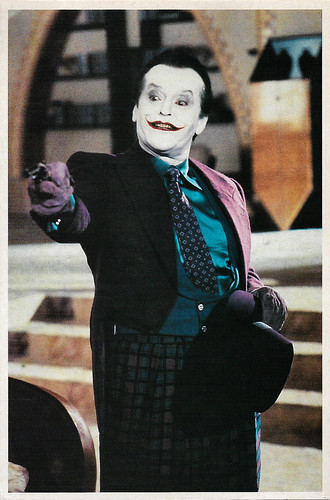
French postcard by Editions Mercuri, no. 87. Photo: Warner Bros Inc. Jack Nicholson in Batman (Tim Burton, 1989).
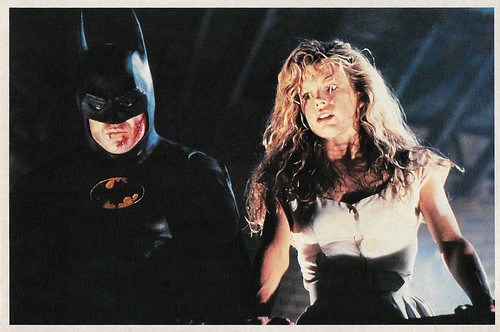
French postcard by Editions Mercuri, no. 88. Photo: Warner Bros Inc. Michael Keaton and Kim Basinger in Batman (Tim Burton, 1989).
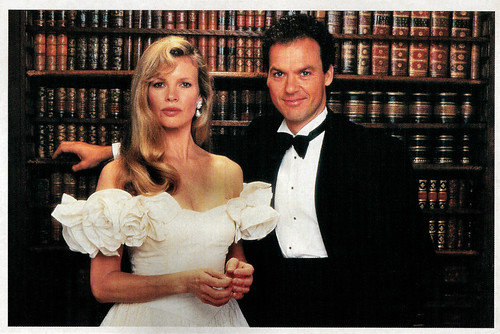
French postcard by Editions Mercuri, no. 89. Photo: Warner Bros. Inc. Kim Basinger and Michael Keaton in Batman (Tim Burton, 1989).

French postcard by Sonis, no. C 62. Photo: Warner Bros inc. Michael Keaton and Kim Basinger in Batman (Tim Burton, 1989).

French postcard by Sonis, no. C 64. Photo: Warner Bros. Inc. Michael Keaton in Batman (Tim Burton, 1989).
Sources: Wikipedia (Dutch, French, and English) and IMDb.
No comments:
Post a Comment